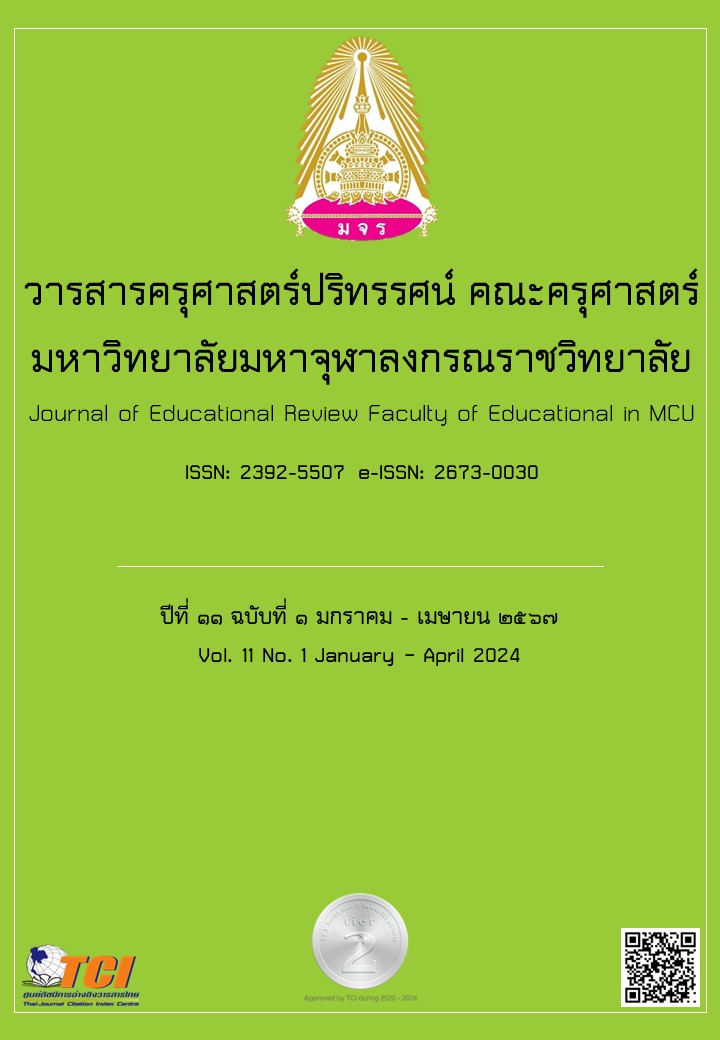DEVELOPMENT OF ANALYTICAL THINKING ABILITY AND TEAMWORK AND COLLABORATION OF LOWER SECONDARY STUDENTS USING 5 STEPS COLLABORATIVE LEARNING PROCESS
Main Article Content
Abstract
The purpose of this study is to investigate the effects of organizing learning using a 5-step collaborative learning process on plants and plant life on analytical thinking ability and teamwork and collaboration of Mathayom 1 students. It is also to study practices in learning management using the 5-step collaborative learning process by collecting data from the analytical thinking ability test, teamwork and collaboration assessment, post-teaching recording form of teacher and student diary forms.The target group is 39 Mathayom 1 students. The research found that students had higher analytical thinking ability after studying, with a statistical significance of .05. The results of the assessment of teamwork and collaboration increased. At the end of the operating cycle, it was found that the evaluation results were at a very good level, accounting for 94.87 percent, and a good level, accounting for 5.13 percent. To practices in learning management, teachers should present stimulants or situations to stimulate interest that are consistent with students' daily lives or previous experiences. Teachers should also design activities that encourage students to brainstorm and exchange opinions through activities such as using sticky notes to write brainstorming ideas. Furthermore, there should be competitive activities with positive reinforcement including team testing at the end of the lesson. Students should be able to practice and express their opinions as well as summarize their knowledge and present it in an exhibition in front of the class and/ or present work in front of the class. Students should also participate in selecting group members.
Article Details

This work is licensed under a Creative Commons Attribution-NonCommercial-NoDerivatives 4.0 International License.
ทัศนะและความคิดเห็นที่ปรากฏในบทความในวารสารฉบับนี้ถือเป็นความรับผิดชอบของผู้เขียนบทความนั้นเพียงผู้เดียว และไม่ถือเป็นทัศนะและความรับผิดชอบของกองบรรณาธิการ
กองบรรณาธิการขอสงวนสิทธิ์ในการคัดเลือกบทความลงตีพิมพ์และจะแจ้งให้เจ้าของบทความทราบหลังจากผู้ประเมินบทความตรวจอ่านบทความแล้ว
ต้นฉบับที่ได้รับการตีพิมพ์ในวารสารครุศาสตร์ปริทรรศน์ คณะครุศาสตร์ มหาวิทยาลัยมหาจุฬาลงกรณราชวิทยาลัย ถือเป็นกรรมสิทธิ์ของคณะครุศาสตร์ มหาวิทยาลัยมหาจุฬาลงกรณราชวิทยาลัย ห้ามนำข้อความทั้งหมดหรือบางส่วนไปพิมพ์ซ้ำ เว้นเสียแต่ว่าจะได้รับอนุญาตจากมหาวิทยาลัยฯ เป็นลายลักษณ์อักษร
References
กรกนก เลิศเดชาภัทร และปริณดา ลิมปานนท์ พรหมรัตน์. (2561). ผลของการสืบสอบแบบร่วมมือรวมพลังที่มีต่อความสามารถในการสร้างคำอธิบายเชิงวิทยาศาสตร์ของนักเรียนมัธยมศึกษาตอนต้น. วารสารครุศาสตร์ จุฬาลงกรณ์มหาวิทยาลัย. 46(2). 1-20.
กฤษณะ โต๊ะดำ. (2565). กระบวนการเรียนรู้แบบรวมพลัง 5 ขั้นตอน (Co-5STEPs) ร่วมกับเทคนิคผังกราฟิกที่มีต่อความสามารถในการคิดวิเคราะห์และผลสัมฤทธิ์ทางการเรียน สาระเศรษฐศาสตร์ของนักเรียนชั้นมัธยมศึกษาปีที่ 2. ในการประชุมหาดใหญ่วิชาการระดับชาติและนานาชาติครั้งที่ 13 มหาวิทยาลัยหาดใหญ่.
ชัยวัฒน์ บวรวัฒนเศรษฐ์. (2559). ยุทธศาสตร์การจัดการเรียนการสอนตามทฤษฎีการเสริมต่อการเรียนรู้. วารสารวิชาการแพรวากาฬสินธุ์ มหาวิทยาลัยกาฬสินธุ์. 3(2). 154-179.
พิมพันธ์ เดชะคุปต์ และพเยาว์ ยินดีสุข. (2563). การเรียนรู้เชิงรุกแบบรวมพลังกับ PLC เพื่อการพัฒนา. พิมพ์ครั้งที่ 4. กรุงเทพมหานคร: สำนักพิมพ์จุฬาลงกรณ์มหาวิทยาลัย.
พีรวุฒิ ยิ่งนอก. (2564). การศึกษาผลสัมฤทธิ์ทางการเรียนและการคิดวิเคราะห์โดยการจัดกิจกรรมการเรียนรู้ด้วยกระบวนการเรียนรู้ 5 ขั้นตอน (5 STEPs) ร่วมกับการจัดการเรียนรู้แบบร่วมมือด้วยเทคนิค STAD เรื่องทรัพยากรธรณีของนักเรียนชั้นมัธยมศึกษาปีที่ 4. วิทยานิพนธ์การศึกษามหาบัณฑิต. มหาวิทยาลัยบูรพา.
ไพฑูรย์ สินลารัตน์ และคณะ. (2560). คิดวิเคราะห์ : สอนและสร้างได้อย่างไร. กรุงเทพมหานคร: สำนักพิมพ์วิทยาลัยครุศาสตร์.
วิจารณ์ พานิช. (2563). หลักสูตรฐานสมรรถนะ. แหล่งที่มา https://shorturl.asia/5NJ3L. สืบค้นเมื่อ 20 ก.ย. 2565.
ศศิวิมล ขอนดอก. (2565). การศึกษาผลสัมฤทธิ์ทางการเรียนและพฤติกรรมการทำงานกลุ่มของนักเรียนชั้นมัธยมศึกษาปีที่ 4 ที่ได้รับการจัดการเรียนรู้แบบสืบเสาะหาความรู้ 5 ขั้น(5E) ร่วมกับการเรียนรู้แบบร่วมมือด้วยเทคนิคจิ๊กซอว์Iเรื่องเซลล์และการทำงานของเซลล์. วารสารครุศาสตร์ปริทรรศน์ คณะครุศาสตร์ มหาวิทยาลัยมหาจุฬาลงกรณราชวิทยาลัย. 9(2). 265-277.
สถาบันส่งเสริมการสอนวิทยาศาสตร์และเทคโนโลยี กระทรวงศึกษาธิการ. (2558). สรุปผลการประเมิน PISA 2015 วิทยาศาสตร์ การอ่าน และคณิตศาสตร์. กรุงเทพมหานคร: สำนักพิมพ์สถาบันส่งเสริมการสอนวิทยาศาสตร์และเทคโนโลยี.
สถาบันส่งเสริมการสอนวิทยาศาสตร์และเทคโนโลยี. (2560). คู่มือการใช้หลักสูตรรายวิชาพื้นฐานวิทยาศาสตร์. แหล่งที่มา https://shorturl.asia/4gy60 สืบค้นเมื่อ 10 พ.ค. 2566.
สำนักงานคณะกรรมการการศึกษาขั้นพื้นฐาน. (2565). สมรรถนะการรวมพลังทำงานเป็นทีม. แหล่งที่มา https://shorturl.asia/Fdw94 สืบค้นเมื่อ 20 ก.ย. 2565.
Irwanto, Rohaeti, E., Widjajanti, E. & Suyanta. (2017). Students’ science process skill and analytical thinking ability in chemistry learning. in AIP Conference Proceedings. AIP Publishing LLC.
Lubis, A. H., Yusup, F., Dasopang, M. D. & Januariyansah, S. (2021). Effectivity of interactive multimedia with theocentric approach to the analytical thinking skills of elementary school students in science learning. Premiere Educandum: Jurnal Pendidikan Dasar dan Pembelajaran. 11(2). 1-3.
Perdana, R., Jumadi, J., & Rosana, D. (2019). Relationship between Analytical Thinking Skill and Scientific Argumentation Using PBL with Interactive CK 12 Simulation. International Journal on Social and Education Sciences. 1(1). 16-23.
Vygotsky, L. S. (1978). Interaction between Learning and Development. in M. Cole, V. John-Steiner, S. Scribner & E. Souberman (Eds.). Mind and Society: The Development of Higher Psychological Processes.


